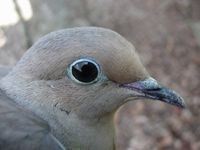|
|
|||
|
THIS WEEK at HILTON POND |
|
During spring and fall migration, we've occasionally seen an Osprey perch in the big White Oak at Hilton Pond Center; For most of the two decades the Center has been in operation, a pair of Red-shouldered Hawks, Buteo lineatus, has included the property as part of its territory. In our mist nets we've caught and the banded five different individuals of this woodland hawk, some of which likely were offspring of the local pair. Whether the adults are the same birds from year to year is not known, but it's entirely possible; Red-shouldered Hawks are known to live as long as 20 years in the wild. During the winter of 2001-2002, our current red-shouldered pair has been hanging around the Center,
After several days of watching the hawk's mysterious pondside behaviors, we finally observed something conclusive on 22 January. The red-shouldered sprang from his regular perch on the Wood Duck box, flew into the shallow water at the other end of the pond, apparently grabbed a large fish, and dragged it to the bank. We were shielded by vegetation from seeing the precise moment of capture, but through binoculars we could see quite clearly that the hawk had a fish hooked through the operculum with the talons of one foot. This was a relatively big fish, and there was no way the Red-shouldered Hawk could actually fly with the prey; the fish was obviously too heavy to lift.The Red-shouldered Hawk hopped and flapped with its prey until it got further up the bank and away from the water's edge--a good thing since the fish was very much alive and flopping vigorously. The hawk "mantled" the fish for a minute or two, spreading both wings to form a sort of umbrella over it--a behavior that may serve to prevent other hawks from stealing the prey. Then he dragged the fish out of view. Since our local red-shouldereds are relatively tolerant of human activity, we decided to walk to the spot along the pond margin where we saw the hawk go into the underbrush. There we found the bird wrestling with the fish--which was still flopping after being out of water for more than 15 minutes. We were able to get within 20 feet of the hyperactive duo until the hawk finally flew to the canopy above. Amazingly, the hawk had dragged the fish at least 60 feet from the edge of the pond.  We couldn't quite get a photo of the hawk with its prey--which turned out to be a sizable Largemouth Bass!--but we did have a yardstick. When we rolled the big fish over for measurements, we saw that an eye and the gills on one side were gone, but the bass was STILL flopping. And no wonder the red-shouldered had been having so much trouble: the fish was 15.5" long--an acceptable catch even for a human angler! There are very few published references to Red-shouldered Hawks eating fish--much less trying to capture one that was more than a foot long and probably weighed up to two pounds. One project in Wisconsin found that red-shouldered nest sites contained remains of 318 different species of prey items; only 3% of them were fish. These included unidentified minnows, Yellow Bullhead, Yellow Perch, unidentified sunfish, Brook Stickleback, and other kinds of unidentified fish--but never Largemouth Bass, Micropterus salmoides. In a much-older field study--done around 1900 when it was "acceptable" to shoot birds of prey Red-shouldered Hawks, like many animals that are not super-specialized in their diets, are opportunistic in what they prey upon and eat. At least one of the local red-shouldereds has learned that lethargic mid-winter Largemouth Bass crowded together in a drought-lowered pond can be easy pickings. The really interesting thing would be to find out whether our resident Red-shouldered Hawks teach such atypical fishing skills to their offspring, perhaps giving rise to a "new breed" of bass-loving Fish Hawks that got their start at Hilton Pond Center. If you enjoy "This Week at Hilton Pond," please help Support Hilton Pond Center for Piedmont Natural History. It's painless, and YOU can make a difference! Osprey photo courtesy of The International Osprey Foundation. Thanks to Stan Moore, Jim Bednarz, Tod Highsmith, and Jim Sorrow for their input on Red-shouldered Hawks and fish. |

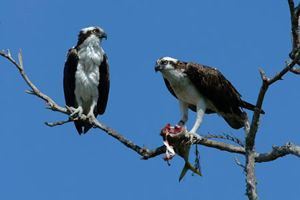 a couple of times we even saw one dive into the water and come up with a fish in its talons. It wasn't surprising that Ospreys (right) would behave in such a way--after all, fish make up so much of their diet that they are sometimes called "Fish Hawks"--but we WERE surprised in recent weeks to see that at least one local Red-shouldered Hawk had started "acting like an Osprey."
a couple of times we even saw one dive into the water and come up with a fish in its talons. It wasn't surprising that Ospreys (right) would behave in such a way--after all, fish make up so much of their diet that they are sometimes called "Fish Hawks"--but we WERE surprised in recent weeks to see that at least one local Red-shouldered Hawk had started "acting like an Osprey."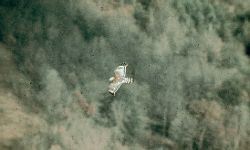 sometimes perching, sometimes soaring (left), and undoubtedly getting ready for another breeding season. The smaller of the two--probably the male, since females are usually larger in birds of prey--has been especially active. He often sits on a Wood Duck box on a tall pole at one end of the pond (below right) and suddenly swoops to land at the edge of the water--which despite six inches of rain in January is still 'way down from the drought.
sometimes perching, sometimes soaring (left), and undoubtedly getting ready for another breeding season. The smaller of the two--probably the male, since females are usually larger in birds of prey--has been especially active. He often sits on a Wood Duck box on a tall pole at one end of the pond (below right) and suddenly swoops to land at the edge of the water--which despite six inches of rain in January is still 'way down from the drought.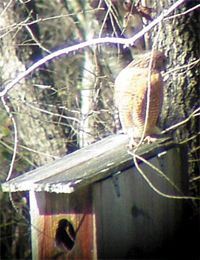 Once last week we actually saw the hawk land feet first on the water's surface about 10 feet from the bank and then take off, flying low through the woods. We suspected our red-shouldered was after a fish, even though this hawk species primarily eats small mammals and amphibians. Although we couldn't tell whether he had caught anything, the fact that he didn't return for several hours suggested he might have been successful and had taken a pre-nuptial offering to the female.
Once last week we actually saw the hawk land feet first on the water's surface about 10 feet from the bank and then take off, flying low through the woods. We suspected our red-shouldered was after a fish, even though this hawk species primarily eats small mammals and amphibians. Although we couldn't tell whether he had caught anything, the fact that he didn't return for several hours suggested he might have been successful and had taken a pre-nuptial offering to the female.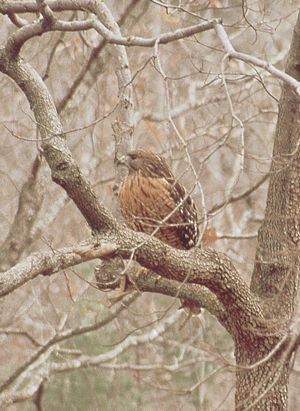
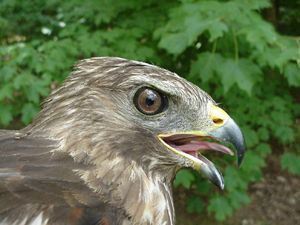 --biologists examined the stomachs of 220 dead Red-shouldered Hawks and found 142 contained mice, moles, and other small mammals; 108 had larger insects and spiders; 39 had amphibians; 20 had reptiles; 12 had birds (plus three with poultry); seven had crayfish; two had "offal" (unidentifiable, partly digested animal matter); one had earthworms; 14 were empty; and only three contained fish. Obviously, for a Red-shouldered Hawk to eat fish is at least uncommon, and maybe quite rare.
--biologists examined the stomachs of 220 dead Red-shouldered Hawks and found 142 contained mice, moles, and other small mammals; 108 had larger insects and spiders; 39 had amphibians; 20 had reptiles; 12 had birds (plus three with poultry); seven had crayfish; two had "offal" (unidentifiable, partly digested animal matter); one had earthworms; 14 were empty; and only three contained fish. Obviously, for a Red-shouldered Hawk to eat fish is at least uncommon, and maybe quite rare.